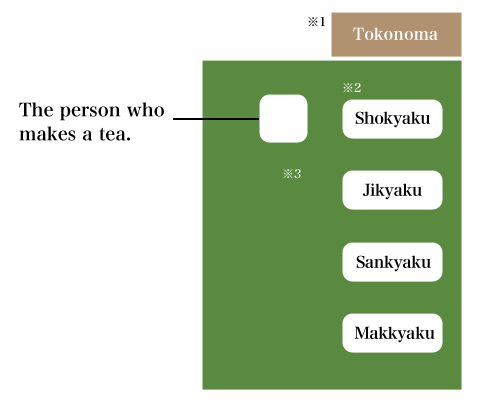This is an informal tea gathering where you can enjoy the various styles of tea ceremony without adherence to any particular school.
As the aim of this event is for visors to enjoy a variety of tea schools, we do not give visitors advance information on which school is holding the ceremonies. However if you are interested, please ask your host on the day about the school and anything else.
Tokyo Grand Tea Ceremony is an informal tea gathering that beginners can comfortably participate in.
Beginners may attend a tea ceremony without preparing anything, but tea ceremony etiquette is to bring "kaishi" paper and "kuromoji" sweet picks. If possible, please bring "kaishi" paper and a sweet pick with you when you attend.
If another participant gives you some advice about etiquette during the tea ceremony, it should be accepted with thanks.
We hope tea aficionados will actively take the role of "shokyaku" and enjoy the tea ceremony. If a beginner should be the designated "shokyaku", we ask you to watch over and support them in a friendly manner.
The Tokyo Grand Tea Ceremony is designed for beginners, so you may attend a tea ceremony without preparing or bringing anything.

When you enter the tea room, do not step on the fabric borders of the tatami mat flooring or on the threshold of the fusuma sliding doors.
Where you sit is very important in the tea ceremony.
In the tearoom, the place nearest the tokonoma (*1) is the seat of honor, and the place furthest from it is the one with least prestige. So the person sitting nearest the tokonoma is the "shokyaku"(*2), or principal guest. As the guest of honor, the "shokyaku" is required to be knowledgeable about the tea ceremony and converse with the host, or "teishu" (*3). Advanced knowledge is necessary for understanding and holding conversation about the design and concept of the tearoom, the tea container, etc.
Seated next to the "shokyaku" is the "jikyaku". Although the "jikyaku" does not need as much knowledge of the tea ceremony as the "shokyaku", he or she is the second most important guest. After the "jikyaku" comes the "sankyaku" and the "yonkyaku". Guests lower than "sankyaku" do not talk to the host, so this is an easy position for beginners. In addition the person seated furthest from the tokonoma is called the "makkyaku, the etiquette for whom sometimes differs from that of other guests, so is considered unsuitable for beginners.
